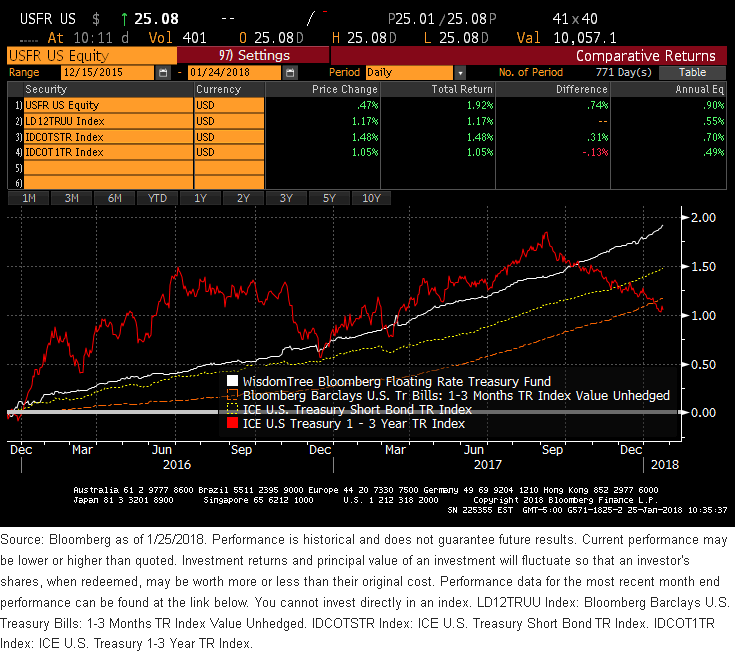Fixed Income: Don’t Fight the Fed, Float with It Instead


One down, seven more FOMC meetings to go after today. There’s no doubt, as 2018 progresses, that the money and bond markets will be wrestling with their Federal Reserve (Fed) rate expectations, an annual rite that has now been taking place since December 2015, when the policy makers began the current hiking cycle. In addition, investors have discovered that Fed rate hikes don’t necessarily impact all Treasury maturities in the same way. In our opinion, instead of “fighting the Fed,” investors should embrace the potential for additional rate increases this year—and possibly into 2019—and prepare their fixed income portfolios accordingly.
That being said, fixed income investors more often than not utilize short-duration strategies when the expectation is for higher interest rates. In other words, funds could be reallocated from intermediate to longer-dated maturities and reinvested into shorter-dated instruments. Some of the more widely used options involve U.S. Treasury securities such as T- bills, or a focus on the 1–3-year T-note sector.

Click here for USFR standardized performance.
However, what if there was an even more optimal strategy? We believe there is an alternative approach investors should explore: floating rate products. Investors looking to mitigate potential interest rate exposure may wish to examine the benefit of floating rate Treasury notes (FRNs). The U.S. Treasury began issuing two-year FRNs in January 2014. The yield is reset weekly based on a reference rate that is determined at the weekly three-month Treasury bill auction. As a result, they have the potential to reset interest rates more frequently as short-term yields drift higher. The WisdomTree Bloomberg Floating Rate Treasury Fund (USFR), which seeks to track the price and yield performance of the Bloomberg U.S. Treasury Floating Rate Bond Index, offers investors a vehicle to follow this type of strategy.
It should be noted that other floating rate vehicles also exist, but they typically include corporate credit in the mix, and this corporate exposure often comes from the financial sector. So, an investor may be buying a rate-structured instrument to hedge against higher rates, but in the process they could also be adding more financial sector exposure to their overall portfolio. USFR contains no corporate exposure and consists only of Treasuries.
Let’s compare apples to apples and look at how USFR has performed against the aforementioned other UST-based short duration options since the Fed implemented its first rate hike at the end of 2015. As the chart above illustrates, as of this writing, USFR has outperformed three widely used UST-based strategies. The largest differentials exist with the Treasury 1–3-year sector (ICE U.S. Treasury 1–3 Year TR Index) and 1–3-month T-bills (Bloomberg Barclays U.S. Treasury Bills: 1–3 Month TR Index Value Unhedged), at 87 and 75 basis points (bps), respectively. Rounding out the slate, the UST floating rate vehicle also registered a higher reading, at +44 bps, with the 1-month to 1-year part of the curve (ICE U.S. Treasury Short Bond TR Index).
Conclusion
Given the Fed’s guidance and market outlook for additional increases in the Fed Funds Rate in 2018, if not beyond, some “Fed protection” seems warranted. Against this backdrop, we feel that utilizing a floating rate product such as USFR, may be better able to insulate investors’ bond portfolio than would a more traditional fixed income investment.
Unless otherwise noted, data source is Bloomberg, as of January 25, 2018.
Important Risks Related to this Article
There are risks associated with investing, including possible loss of principal. Securities with floating rates can be less sensitive to interest rate changes than securities with fixed interest rates, but may decline in value. The issuance of floating rate notes by the U.S. Treasury is new and the amount of supply will be limited. Fixed income securities will normally decline in value as interest rates rise. The value of an investment in the Fund may change quickly and without warning in response to issuer or counterparty defaults and changes in the credit ratings of the Fund’s portfolio investments. Due to the investment strategy of this Fund, it may make higher capital gain distributions than other ETFs. Please read the Fund’s prospectus for specific details regarding the Fund’s risk profile.


